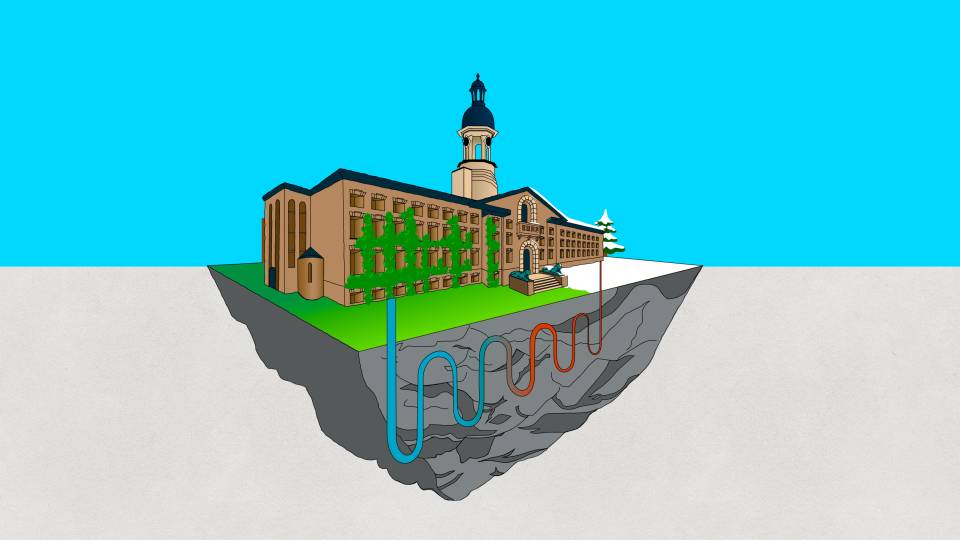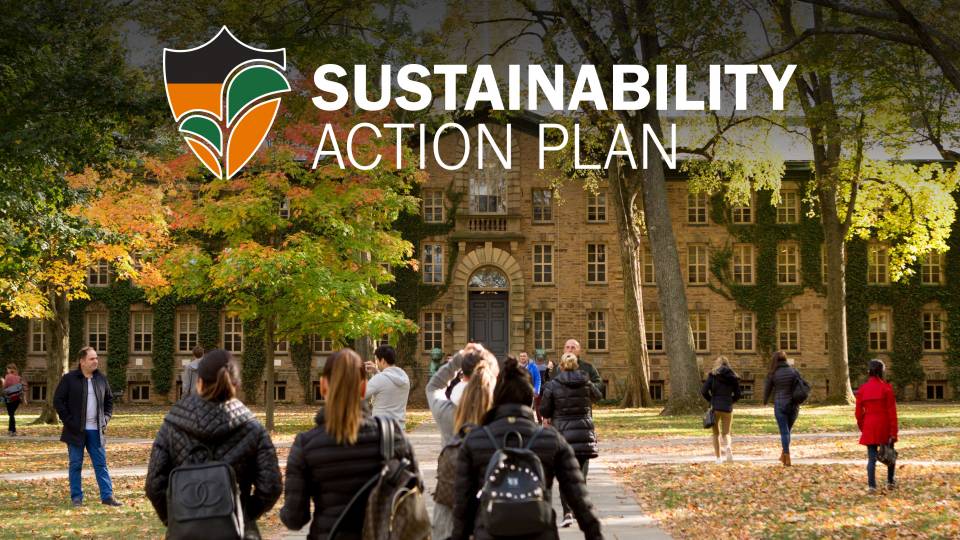
For four weeks this summer, a nocturnal visitor to Princeton’s campus might have encountered a strange sight — a wooden cart rolling through campus on a bicycle wheel, light meters hanging from a pole in front and two graduate students pushing in back. The Rube Goldberg-like contraption is the centerpiece of a project to collect data on pathway lighting on campus.
“We wanted to know, ‘What are the real light levels as you walk through campus?‘” said Paul Lewis(Link is external), an assistant professor of architecture(Link is external), who is supervising the project. To find out, the students walked every single path on campus, recording information about the 1,700 University-owned pathway lights.
The goal of the project is to measure light levels throughout the campus and use the information to examine ways to reduce the energy spent on lighting. The students also are developing alternative designs for illumination that embrace sustainable technology. The project is funded by the High Meadows Foundation, which supported 16 projects at Princeton this year that seek to improve sustainability.
Three graduate students in the School of Architecture are working on the project with Lewis. Together they constructed their light-metering cart out of recycled parts and materials from Lewis’ architecture firm, LTL Architects, located in New York City. The wheel is borrowed from Lewis’ bike. The contraption traveled through the streets of Manhattan to Penn Station, where it boarded the train for Princeton. “Although we got curious looks,” said graduate student Jean Choi, “the machine has led to an efficient and effective measuring process of the entire campus.”

The students took ground and vertical light measurements every 10 feet and produced this contour map visualizing the ground illuminance. Dark blue has the lowest illuminance, yellow is midway and red is highest. (Map: Courtesy of the School of Architecture)View larger version
Two of the students pushed it along campus pathways from 10 p.m. to 4:30 a.m. every night for weeks, recording the position and type of 1,700 lights. The students took ground and vertical light measurements every 10 feet and produced light contour maps of the entire campus. They analyzed the history of campus lighting and the types of lights currently used. They also consulted with leading lighting designers and visited other campuses to examine how other institutions use lighting.
“I didn’t have much awareness of the lighting on campus before,” said Thomas Wong, who is earning a master’s degree in architecture. Working on this project has shown him the importance of lighting, he said. “In the end it makes a big difference in how you see a building and how the architect communicates the design.” He’s also learned that better lighting doesn’t necessarily mean more lighting. “It’s about how you frame views and direct angles to use light more effectively,” he said.
“Sometimes, as architects, we don’t consider lighting as much as we should,” said Yu-Cheng Koh, another student involved in the project, who returned to campus to study for a master’s degree in architecture after earning his bachelor’s degree at Princeton in East Asian studies. Looking so closely at lighting “will inform buildings I design in the future,” he said.

Paul Lewis, an assistant professor of architecture, is supervising the students on the project. They are wrestling with competing issues, such as trying to use less energy yet keeping in mind that better illuminated pathways encourage people to walk and use bicycles, which conserve energy they might expend driving.
The students are wrestling with the competing issues involved in lighting. They hope to find ways to develop lighting that uses less energy, while keeping in mind that better illuminated pathways encourage people to walk and use bicycles, which conserve energy they might expend driving.
The students have met with University architects and other members of the facilities department to ask questions and discuss their work. A new numbering system for the pathway lights that they devised will be turned over to those in facilities who work with lighting. As a result of the research and proposed numbering system, the students hope there will be a more systematic and efficient approach to the future campus planning of lighting.
The students gathered “very useful data that will help us compare areas of lighting that work well with areas that need improving,” said Dan Casey, coordinating architect in the Office of the University Architect(Link is external). He is the project manager for a campuswide study of outdoor lighting being conducted by the University to develop standards and recommendations for lighting of all campus walks, roads, building entries and parking lots. The plan will examine campus lighting from the standpoint of security, sustainability and aesthetics.
The students’ data “is going to be input directly” into the outdoor lighting study, said Thomas Nyquist, director of engineering for the Office of Engineering Services(Link is external), who also met with the students.

The students have devised a new numbering system for the pathway lights that they will turn over to those in the facilities department who work with lighting. As a result of the research and proposed numbering system, the students hope there will be a more systematic and efficient approach to the future campus planning of lighting.
When the project is finished in mid-August, the students will prepare a report and exhibition at the School of Architecture summarizing their work which will include maps of light levels and light locations; information on the configuration, height and type of pathway lights on campus; and calculations of energy use. The report also will contain information on innovative lighting approaches at other locations as well as designs and mock-ups of new light prototypes.
“What’s exciting is that the project partners facilities’ efforts with academic research,” giving students the power to effect real change, said Shana Weber, manager of the Office of Sustainability(Link is external). “They’re using the campus as a laboratory, having fun and encouraging innovative thinking. I love the fact that they transported their homemade research cart to campus using public transportation. That is the spirit of sustainability in action. I am also excited by the possibility that what they learn may inform much larger-scale efforts.”





